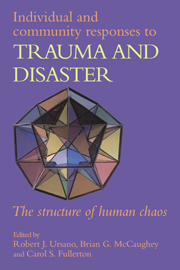Book contents
1 - Trauma and disaster
from Part I - Introduction
Published online by Cambridge University Press: 13 October 2009
Summary
You spoiled it: why did you spoil it? I'd like everything to be normal. Michael Jackson … wanted everyone to be normal. I was in the hospital as a psychiatric patient, but I am not a psychiatric patient at all. I don't have any complaints … seems my brain is too much concentrated on. I love my father … I'd like you to be healthy. I'd like me to be healthy and to be sent to America.
Our, our, our Yerivan. My mother did her hair like this. First and foremost I must become like my mother … I am ashamed. This is my secret. It is not a secret.
(Quote from a 16 year-old girl shortly after the 1988 Armenian earthquake.)Trauma and disasters are a part of our everyday lives, despite our wishes. With the advent of mass communications, we are more aware than ever of the frequency of these events; we see and hear both manmade and natural disasters from around the globe rather than only in our own community. In the modern political world, the manmade traumas of war, chemical weapons, terrorism, hostage events, and nuclear accidents are of particular concern. These traumatic events often have widespread and devastating impacts on health and national and community stability, even when only a few individuals are primary victims.
The human chaos of disasters is not random.
- Type
- Chapter
- Information
- Individual and Community Responses to Trauma and DisasterThe Structure of Human Chaos, pp. 3 - 28Publisher: Cambridge University PressPrint publication year: 1994
- 40
- Cited by

